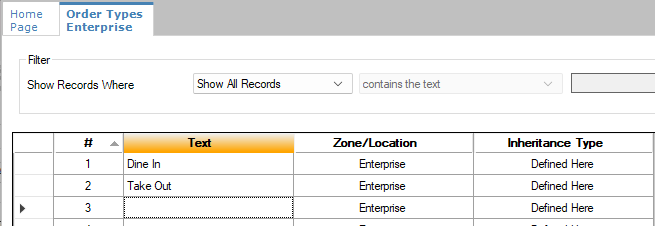- Configuration Guide
- Order Types and Channels
- Order Types
- Configuring Order Types
Configuring Order Types
- Select the Enterprise, property, or zone, click Descriptors, and then click Order Types.
- In the Text field, enter an order type name (for example, Dine In, Take Out, Drive Thru).
Figure 14-1 Example of Order Types

- Click Save.
- Select the Enterprise, property, revenue center, or zone, click Setup, and then click Order Type Parameters.
- For each order type record, select the appropriate options
as described in the following table:
Table 14-3 Order Type Options
Option Description 1 - Print on Customer Receipt and Guest Check
Select this option to print the order type name on customer receipts and guest checks.
2 - Print on Order Printer
Select this option to print the order type name on order printers.
3 - Enable Guest Count by Menu Item in Transaction Services
Select this option to enable transaction services to count guests like POS operations.
This option must be enabled along with Menu Item Classes option 11 - Add to Guest Count in order for the guest count to be incremented.
4 - Do Not Post Transactions to Tip Report Totals
Select this option to exclude sales for the order type from Tip Report Totals.
5 - Perform Auto Combo Recognition
Select this option to have workstations automatically perform auto combo recognition when the workstation operator changes the workstation to the order type.
6 - Transaction Cancel Default
Select this option when starting orders without an order type.
When a workstation operator begins a transaction and cancels it before selecting an order type, the POS client requires the workstation operator to associate the check with an order type for posting purposes. The POS client finds the first order type that has this option selected and uses it.
Deselect this option to have the POS client use the first order type record in the list to associate with the check.
8 - Enable Routing Order by Order Type
Select this option to control order routing by the order type. The workstation order devices must be set for all possibilities and use this as an override to disable order devices. Order channel routing takes precedence over order type routing if both are set.
Deselect this option if you are using Dynamic Order Mode (DOM) on KDS Displays as it is not compatible.
9 - KDS Allow Item Print on Item All Prep Done
See Printing Runner Chits by Order Type in the Oracle MICROS Simphony KDS Configuration and User Guide for more information.
10 - Suppress Dining Course
See Suppressing Dining Courses from Orders in the Oracle MICROS Simphony KDS Configuration and User Guide for more information.
11 - Forgive Inclusive Tax
Select this option to forgive the Inclusive Tax for eligible Menu Items (Australian GST only).
12 - Always Use KDS Prep Time
See Setting the Relative Capacity Used By Each Menu Item in the Oracle MICROS Simphony KDS Configuration and User Guide for more information.
13 - Hide Custom Tip Button
Select this option to instruct the payment device to hide the Custom Tip button.
14- Hide No Tip Button
Select this option to instruct the payment device to hide the No Tip button.
16 - Use Dynamic Tip
Select this option to define a threshold for suggesting tip amounts or percentages to guests. See Configuring Dynamic Tipping for more information and an example.
- Click the ellipsis point (...) button
in the Tax Mask column, select the tax rates
for the order type, and then click OK.
If you are creating an order type for a delivery service provider, do not select any tax rates in the Tax Mask column.
- Select Active for each order type that you want to activate.
- Set the desired Service Level Time value (in minutes) for each active order type.
The Service Level Time setting supports the ability to set a pickup time for placed orders. It allows for a requested order to be prepared within an allotted timeframe, ensuring that orders are made ready for pickup by customers or a delivery service. The value set in this column for active order types signifies the preparation time (in minutes) for a given order.
- Click Save.
- Select the revenue center, click Setup, and then click RVC Parameters.
- (Optional) Select the Default Order Type from the drop-down list. This is the order type that is active when a workstation operator begins a check.
- Click Save.
- To override the default order type setting for a workstation:
- Select the property, click Setup, and then click Workstations.
- Double-click the workstation.
- Click the Transactions tab.
- Select the Default Order Type from the drop-down list.
- Click Save.
Parent topic: Order Types